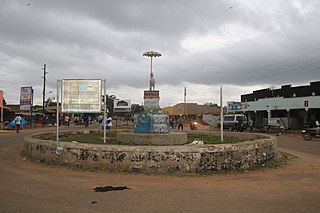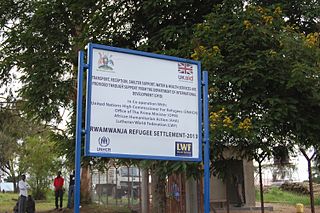Related Research Articles

Adjumani District is a district in Northern Uganda. Like most other Ugandan districts, it is named after its 'chief town', Adjumani, where the district headquarters are located.

Adjumani is a town in the Northern Region of Uganda. It is the main municipal, administrative, and commercial centre of Adjumani District. The district is named after the town.

Rwamwanja Refugee Settlement is a refugee camp in Kamwenge District in southwestern Uganda and is home to nearly 70,000 refugees.
South Sudanese refugees are persons originating from the African country of South Sudan, but seeking refuge outside the borders of their native country. The world's youngest independent country has a recent and troubled history of prolonged conflicts and ecosystem mismanagement such as overlogging, which has led to desertification. These forces have resulted not only in violence and famine, but also the forced migration of large numbers of the population, both inside and outside the country's borders. South Sudan was cited as the largest refugee crisis in 2016, being the world's third largest, followed by Syria and Afghanistan. As of 2022, the UNHCR estimated that there were 2.4 million refugees under its mandate originating from South Sudan, making the country the fifth largest source of refugees.
Kyangwali Refugee Settlement is a refugee camp in the Kibuube District in western Uganda. April 2024, Kyangwali is home to 137,183 Refugees.

Rhino Camp Refugee Settlement is a refugee camp located in the districts of Madi-Okollo and Terego District in North Western Uganda.
Kyaka II Refugee Settlement is a refugee camp in Kyegegwa District in western Uganda.
Pagirinya Refugee Settlement is a refugee camp in Eastern Adjumani District in Northern Uganda.
Nyumanzi Refugee Settlement is a refugee camp in Adjumani District in northwestern Uganda. Established in 2014, it hosts about 52,000 South Sudanese refugees.
Oruchinga Refugee Settlement is a refugee camp in Isingiro District in Southern Uganda.

Alere 2 Refugee Settlement is located in Adjumani District in the Northern Region of Uganda.
Baratuku refugee settlement is a refugee settlement in the Adjumani district Uganda
Mungula II Refugee Settlement is a refugee camp found in Adjumani District Itirikwa subcounty in Northern Uganda.
Olua I Refugee settlement is a refugee camp in eastern Adjumani District in Northern Uganda. The Refugee settlement has its primary country as Uganda and other country south Sudan.
Oliji refugee settlement is a refugee camp in Adjumani District of Uganda.

Boroli refugee settlement is a refugee camp located in the Pakele Sub County of Adjumani District Northern Region, of Uganda.
The Agojo refugee settlement is a refugee camp in the Adjumani District of Northern Uganda, opened in 2016 in response to an influx of South Sudanese refugees fleeing the insecurity in their country. It is located 16 kilometres (10 mi) west of the town of Adjumani.

The Maaji refugee settlements are three refugee camps located in Adjumani District in the Northern Region of Uganda, established in 1997. In June 2018, there were 41,764 registered refugees, accounting for 10% of the district's total population. It has primarily admitted refugees from the Second Sudanese Civil War and the ongoing South Sudanese Civil War. The settlements have been attacked several times by the Lord's Resistance Army, along with other camps in the region such as the Baratuku refugee settlement.
Ayilo 1 refugee settlement is a prominent refugee camp located in Adjumani District, situated in the Northern Region of Uganda.

Lobule Refugee Settlement is a prominent refugee camp located in Koboko District, Northern Uganda.
References
- 1 2 3 Uganda Refugee Response Monitoring Settlement Fact Sheet: Elema (June 2018). "relief web". relief web.
{{cite web}}: CS1 maint: numeric names: authors list (link) - ↑ "Uganda Refugee Response Monitoring Settlement Fact Sheet Elema" (PDF). June 2018.
- ↑ Data 2 UNHCR (2019-06-01). "Elema Settlement HLP Factsheet 2019". data2 UNHCR.
{{cite web}}: CS1 maint: numeric names: authors list (link) - ↑ data2 UNHCR. "Elema Settlement HLP Factsheet 2019".
{{cite web}}: CS1 maint: numeric names: authors list (link) - ↑ relief web. "Uganda: Elema Refugee Settlement Map Adjumani as of 01 March 2018".